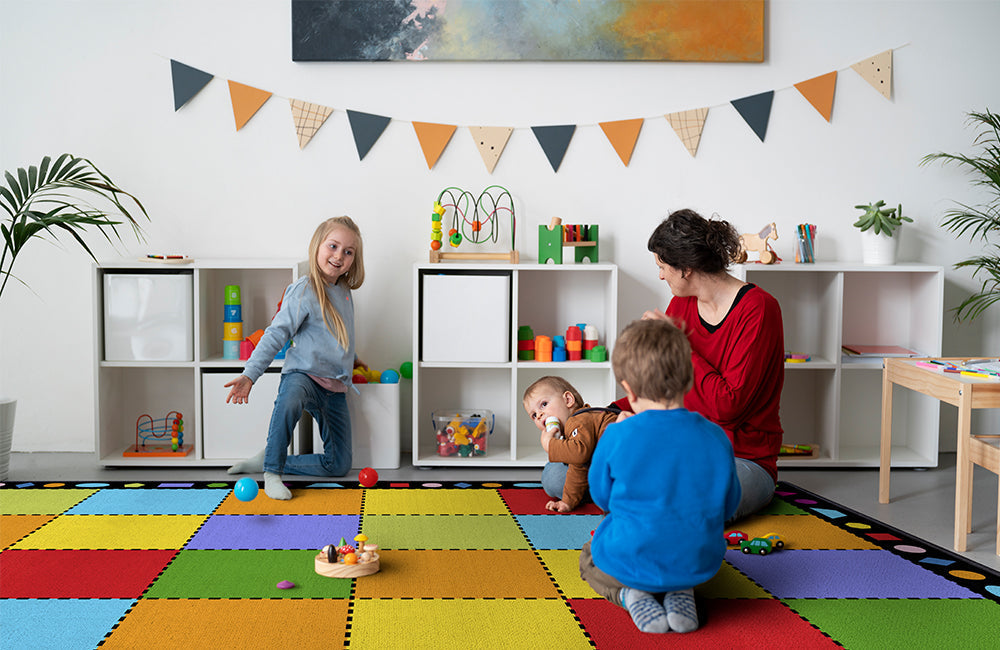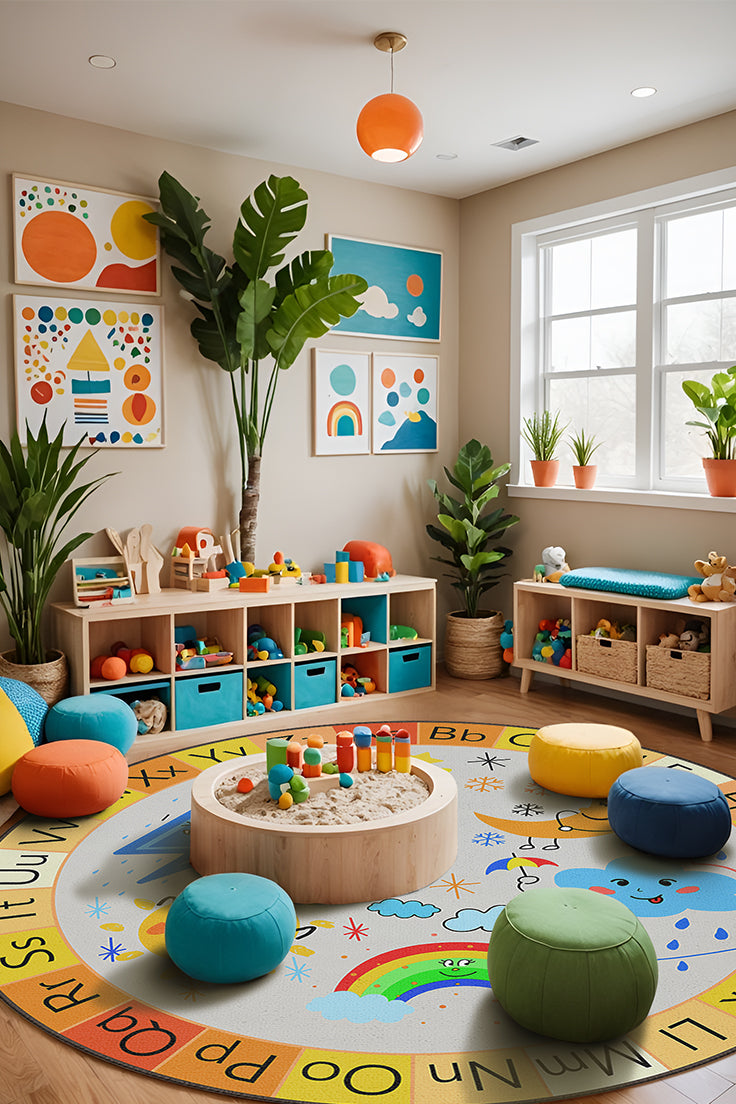Why Classroom Rug Hygiene Matters More Than Ever
Research shows that children engage in 37% longer periods of sustained attention when positioned on appropriately cushioned surfaces versus hard flooring.
However, these same surfaces can harbor bacteria, allergens, and contaminants without proper maintenance protocols.
Health Impact Statistics:
- Nearly 20 million Americans are affected by dust mite allergies, which carpets can aggravate
- Research from the National Library of Medicine reveals that bacteria can persist on fabrics for up to 206 days
- Students can miss up to 25% of instructional content in acoustically poor environments
Professional Daily Maintenance Protocol
Morning Preparation (5 minutes)
- Visual Inspection - Check for stains, spills, or debris from previous day
- Spot Treatment - Address any visible spots with appropriate cleaning solutions
- Surface Debris Removal - Use handheld vacuum for crumbs and surface particles
Throughout the Day
- Immediate Spill Response - Blot liquids immediately with clean, absorbent materials
- Dry Soil Prevention - Encourage students to shake out art supplies and snacks away from rug areas
- Traffic Pattern Management - Rotate seating arrangements weekly to prevent wear patterns
End-of-Day Routine (10 minutes)
- Comprehensive Vacuuming - Daily vacuuming is advised for carpeted areas with heavy foot traffic
- Sanitization - Use EPA-approved antimicrobial treatments on high-touch areas
- Air Circulation - Ensure proper ventilation overnight for moisture control
Weekly Deep Cleaning Strategies
Monday: Preventive Care
- Apply fabric protection spray to high-traffic zones
- Inspect rug edges for fraying or damage
- Check for embedded debris in rug fibers
Wednesday: Mid-Week Refresh
- Steam clean high-traffic areas using portable equipment
- Treat any persistent odors with enzymatic cleaners
- Rotate rug positioning if possible to distribute wear
Friday: Weekly Assessment
- Document any staining or wear patterns
- Plan weekend deep cleaning if needed
- Prepare maintenance schedule for following week
Advanced Stain Removal Techniques
Art Supply Accidents
- Paint Spills: Scrape excess, apply cold water, blot with microfiber cloth
- Glue Mishaps: For major glitter disasters, pressing play dough onto the rug picks up the sparkly stuff surprisingly well
- Marker Stains: Use isopropyl alcohol on water-based markers, specialized solvents for permanent markers
Food and Beverage Spills
- Juice Boxes: Blot immediately, rinse with cold water, apply enzyme cleaner
- Snack Crumbs: Vacuum thoroughly, use lint roller for fine particles
- Mystery Stains: For mysterious rug smells, baking soda is your ride-or-die solution
Biological Incidents
- Follow strict sanitization protocols using CDC-approved disinfectants
- Ensure complete moisture removal to prevent bacterial growth
- Consider professional cleaning for significant contamination events
Seasonal Maintenance Calendar
Fall Preparation (August-September)
- Professional deep extraction cleaning before school year
- Apply protective treatments to extend rug life
- Train custodial staff on new cleaning protocols
Winter Maintenance (December-February)
- Twice a year, carpet should undergo extraction cleaning by trained custodians or professional cleaning services, with suggested times including winter holiday break
- Increase cleaning frequency during flu season
- Monitor humidity levels to prevent mold growth
Spring Renewal (March-May)
- Assess rug condition for end-of-year decisions
- Deep clean before state testing periods
- Plan summer replacement or refurbishment
Summer Restoration (June-August)
- Professional steam cleaning and sanitization
- Repair any damage from academic year
- Apply protective coatings before storage
Technology-Enhanced Cleaning Solutions
Smart cleaning robots equipped with sensors and AI can find the best routes and deliver spotless results are revolutionizing classroom maintenance. Consider investing in:
Automated Cleaning Systems
- Robotic vacuums for daily maintenance
- Air purification systems for improved indoor air quality
- Smart monitoring systems for cleaning schedule optimization
Advanced Cleaning Products
- The eco-friendly carpet cleaning market is projected to reach 964.1 million by 2025
- Antimicrobial treatments with extended protection
- Color-safe brightening agents for vibrant learning environments
Choosing the Right Educational Rugs
When selecting classroom rugs, prioritize materials designed for educational environments. Quality educational rugs should feature:
Safety-First Design
- Non-toxic Materials - Free from PVC, phthalates, and lead compounds
- Slip-Resistant Backing - Prevents accidents during active learning
- Rounded Edges - Reduces trip hazards and wear points
Maintenance-Friendly Features
- Stain-Resistant Fibers - Easier cleanup and longer lifespan
- Antimicrobial Treatments - Built-in protection against bacteria and odors
- Machine Washable Options - Simplified deep cleaning processes
Educational Benefits
- Acoustic Properties - Carpet is 10 times more efficient in reducing noise compared to other flooring options
- Defined Learning Spaces - Visual boundaries for classroom management
- Interactive Designs - Educational patterns that support curriculum goals
Cost-Effective Maintenance Planning
Budget-Friendly Solutions
- Implement student helper programs for daily maintenance
- Bulk purchase eco-friendly cleaning supplies
- Schedule professional cleanings during school breaks for cost savings
ROI Considerations
- Quality rugs with proper maintenance last 5-7 years versus 2-3 years without care
- The carpet cleaning industry has grown at a CAGR of 3.6% between 2019 and 2024, making professional services more accessible
- Reduced replacement costs offset cleaning investment
Sustainable Practices
- Use concentrated, refillable cleaning products
- Implement water-efficient cleaning methods
- Partner with local green cleaning services
Health and Safety Compliance
CDC Guidelines Implementation Schools should follow procedures for routine cleaning, sanitizing, and disinfecting, with daily cleaning and sanitizing of surfaces and objects that are touched often.
Classroom rugs fall under this guidance as high-touch surfaces requiring regular attention.
Documentation Requirements
- Maintain cleaning logs for health inspections
- Track chemical usage for safety compliance
- Record any incidents or deep cleaning events
Staff Training Protocols
- Proper chemical handling and dilution ratios
- Personal protective equipment requirements
- Emergency spill response procedures
Future-Proofing Your Classroom Hygiene Program
The global cleaning services market size was about USD 415.93 billion in 2024 and is expected to grow at a rate of 6.9% from 2025 to 2030. This growth reflects increased awareness of cleanliness importance in educational settings.
Emerging Trends to Monitor
- Smart Sensor Technology - Real-time air quality and contamination monitoring
- Sustainable Materials - Bio-based cleaning products and recyclable rug materials
- Integrated Health Systems - Connecting cleaning schedules with illness tracking
Professional Development
- Regular training on new cleaning technologies
- Certification programs for educational facility maintenance
- Staying current with updated health guidelines and regulations
Conclusion
Maintaining pristine classroom rugs requires systematic daily care, strategic weekly maintenance, and seasonal deep cleaning protocols.
By implementing these professional-grade hygiene practices, educators create healthier learning environments that support student success while maximizing rug investment lifespan.
Key Takeaways:
- Daily vacuuming and immediate spill response prevent 80% of maintenance issues
- Professional cleaning twice yearly extends rug life significantly
- Proper maintenance protocols support student health and academic performance
- Investment in quality educational rugs pays dividends through longevity and performance
External Resources:
- CDC Everyday Actions for Schools - Official infection prevention guidelines
- Carpet and Rug Institute - Industry standards and maintenance protocols
- WHO Hand Hygiene Guidelines - International health and hygiene standards




Leave a comment
This site is protected by hCaptcha and the hCaptcha Privacy Policy and Terms of Service apply.